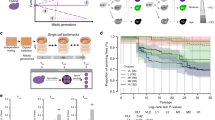Abstract
A Colcemid-resistant Chinese hamster line with an altered form of β-tubulin was used in studies of the expression of spindle proteins in interspecific cell hybrids. Eight hybrids between this line, and a Colcemid-sensitive mouse cell line, were studied. The altered hamster β-tubulin was not expressed as an increased resistance to Colcemid in any hybrid. Since the complete hamster chromosome complement was represented among the hybrids, the absence of altered β-tubulin is not due to segregation of the mutant hamster β-tubulin gene. We suggest either that the hamster β-tubulin gene is repressed in hybrids, or that hamster β-tubulin is excluded from the spindle in hybrid cells. We compare these findings with previous reports of the repression of other highly active, moderately repeated constitutive genes in interspecific hybrids.
Similar content being viewed by others
References
Ajiro K, Zweldler A, Borun T and Croce CM 1978 Species-specific suppression of histone H1 and H2B production in human/mouse hybrids.Proc. Natl. Acad. Sci. USA 75: 5599–5603
Bernhard H P 1976 The control of gene expression in somatic cell hybrids.Int. Rev. Cytol. 47: 289–325
Cabral F, Sobel M E and Gottesman M M 1980 CHO mutants resistant to colchicine, colcetnid or griseofulvin have an altered β-tubulin.Cell 20: 29–36
Eliceiri GL and Green H 1969 Ribosomal RNA synthesis in human-mouse hybrid cells.J. Mol. Biol. 41: 253–260
Ephrussi B 1972Hybridization of somatic cells (Princeton, NJ: Princeton University Press) Leversha M, Sinfield C and Webb G C 1980 Rapid and reliable methods for G- and C-banding of human and other mammalian chromosomes.Aust. J. Med. Lab. Sci. 1: 139–143
Ling V, Aubin J E, Chase A and Sarangi F 1979 Mutants of Chinese hamster ovary (CHO) cells with altered Colcemid-binding affinity.Cell 18: 423–430
Miesfeld R and Arnheim N 1984 Species-specific rDNA transcription is due to promoter-specific binding factors.Mol. Cell Biol. 4: 221–227
Miesfeld R, Sollner-Webb B, Croce C and Arnheim N 1984 The absence of a human-specific ribosomal DNA transcription factor leads to nucleolar dominance in mouse human hybrid cells.Mol. Cell. Biol. 4: 1306–1312
Miller D A, Dev V G, Tantravahi R and Miller O J 1976 Suppression of human nucleolus organiser activity in mouse-human somatic hybrid cells.Exp. Cell Res. 101: 235–243
Miller O J, Miller D A, Dev V G, Tantravahi R and Croce C M 1976 Expression of human and suppression of mouse nucleolus organiser activity in mouse-human somatic cell hybrids.Proc. Natl. Acad. Sci. USA 73: 4531–4535
Onishi T, Berglund C and Reeder RH 1984 On the mechanism of nucleolar dominance in mouse-human somatic cell hybrids.Proc. Natl. Acad. Sci. USA 81: 484–487
Ringertz N R and Savage R E 1976Cell hybrids (New York: Academic Press)
Seabright M 1971 A rapid banding technique for human chromosomes.Lancet 2: 971–972
Szybalski W, Szybalska EH and Ragni G 1962 Genetic studies with human cell lines.Natl. Cancer Inst. Monogr. 7: 75–89
Weiss M C 1976 The use of somatic cell hybridization to probe the mechanisms which maintain cell differentiation. InProceedings of the Fifth International Congress of Human Genetics (eds) S Armendares and R Lisker (Amsterdam: Excerpta Medica) pp. 284–292
Worton R G, Ho C C and Duff C 1977 Chromosome stability in CHO cells.Somatic Cell Genet. 3: 27–45
Author information
Authors and Affiliations
Rights and permissions
About this article
Cite this article
Zelesco, P.A., Graves, J.A.M. Genomic instability in interspecific cell hybrids III. Repression of Colcemid resistance in hybrids suggests preferential β-tubulin expression. J. Genet. 67, 87–94 (1988). https://doi.org/10.1007/BF02927788
Received:
Issue Date:
DOI: https://doi.org/10.1007/BF02927788




